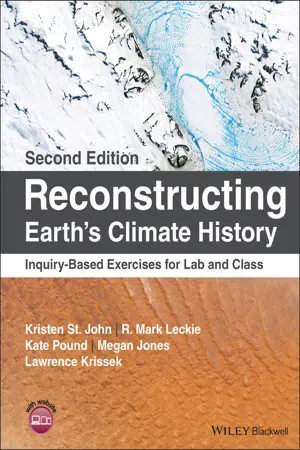
Reconstructing Earth's Climate History
Inquiry-Based Exercises for Lab and Class
- English
- ePUB (mobile friendly)
- Available on iOS & Android
Reconstructing Earth's Climate History
Inquiry-Based Exercises for Lab and Class
About this book
There has never been a more critical time for students to understand the record of Earth's climate history, as well as the relevance of that history to understanding Earth's present and likely future climate. There also has never been a more critical time for students, as well as the public-at-large, to understand how we know, as much as what we know, in science. This book addresses these needs by placing you, the student, at the center of learning. In this book, you will actively use inquiry-based explorations of authentic scientific data to develop skills that are essential in all disciplines: making observations, developing and testing hypotheses, reaching conclusions based on the available data, recognizing and acknowledging uncertainty in scientific data and scientific conclusions, and communicating your results to others.
The context for understanding global climate change today lies in the records of Earth's past, as preserved in archives such as sediments and sedimentary rocks on land and on the seafloor, as well as glacial ice, corals, speleothems, and tree rings. These archives have been studied for decades by geoscientists and paleoclimatologists. Much like detectives, these researchers work to reconstruct what happened in the past, as well as when and how it happened, based on the often-incomplete and indirect records of those events preserved in these archives. This book uses guided-inquiry to build your knowledge of foundational concepts needed to interpret such archives. Foundational concepts include: interpreting the environmental meaning of sediment composition, determining ages of geologic materials and events (supported by a new section on radiometric dating), and understanding the role of CO2 in Earth's climate system, among others. Next, this book provides the opportunity for you to apply your foundational knowledge to a collection of paleoclimate case studies. The case studies consider: long-term climate trends, climate cycles, major and/or abrupt episodes of global climate change, and polar paleoclimates. New sections on sea level change in the past and future, climate change and life, and climate change and civilization expand the book's examination of the causes and effects of Earth's climate history.
In using this book, we hope you gain new knowledge, new skills, and greater confidence in making sense of the causes and consequences of climate change. Our goal is that science becomes more accessible to you. Enjoy the challenge and the reward of working with scientific data and results!
Reconstructing Earth's Climate History, Second Edition, is an essential purchase for geoscience students at a variety of levels studying paleoclimatology, paleoceanography, oceanography, historical geology, global change, Quaternary science and Earth-system science.
Frequently asked questions
- Essential is ideal for learners and professionals who enjoy exploring a wide range of subjects. Access the Essential Library with 800,000+ trusted titles and best-sellers across business, personal growth, and the humanities. Includes unlimited reading time and Standard Read Aloud voice.
- Complete: Perfect for advanced learners and researchers needing full, unrestricted access. Unlock 1.4M+ books across hundreds of subjects, including academic and specialized titles. The Complete Plan also includes advanced features like Premium Read Aloud and Research Assistant.
Please note we cannot support devices running on iOS 13 and Android 7 or earlier. Learn more about using the app.
Information
Table of contents
- Cover
- Table of Contents
- Title Page
- Copyright Page
- The Authors
- Foreword from First Edition
- Acknowledgments
- Book Introduction to the Second Edition for Students and Instructors
- Chapter 1: Introduction to Paleoclimate Records
- Chapter 2: Seafloor Sediments
- Chapter 3: Geologic Time and Geochronology
- Chapter 4: Paleomagnetism and Magnetostratigraphy
- Chapter 5: Microfossils and Biostratigraphy
- Chapter 6: CO2 as a Climate Regulator During the Phanerozoic and Today
- Chapter 7: Oxygen Isotopes as Proxies of Climate Change
- Chapter 8: Climate Cycles
- Chapter 9: The Paleocene–Eocene Thermal Maximum (PETM) Event
- Chapter 10: Glaciation of Antarctica
- Chapter 11: Antarctic Climate Variability in the Neogene
- Chapter 12: Pliocene Warmth as an Analog for Our Future
- Chapter 13: Climate, Climate Change, and Life
- Chapter 14: Climate Change and Civilization
- Index
- End User License Agreement